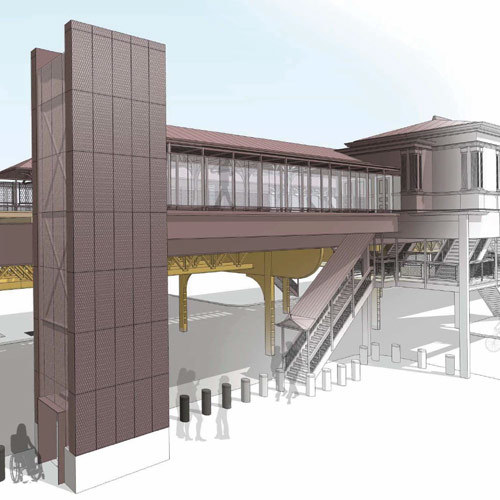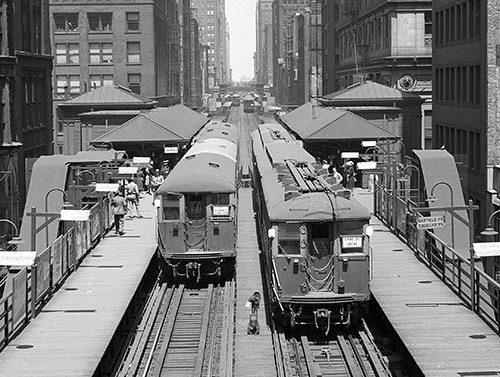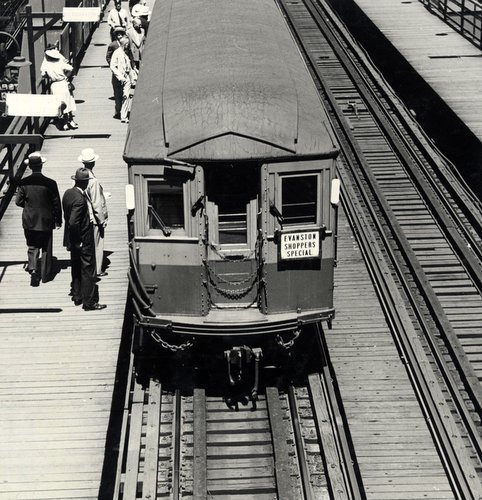Opened in 1897 and designated a Chicago Landmark in 2017, Quincy is one of our oldest and best-preserved stations. A $18.2 million renovation preserved its history while making the station accessible for customers with disabilities. The renovation was completed in 2018.
About the project
The Quincy station provides more than 2.2 million rides annually on the Brown, Orange, Pink and Purple lines and is a major multi-modal transfer point for 10 bus routes. This key station also provides convenient connections to Union Station and the LaSalle Street Metra Station.
The renovation added two elevators to the historic station on either side of Wells Street on the south end of each platform. The elevators connect to the stationhouse for both the Inner Loop (Orange, Purple, Pink Lines) and Outer Loop (Brown Line) platforms. In keeping with the historical look of the station, the elevator tower exteriors mimic patterns on the station’s historic railings. The accessibility improvements are another step toward our push toward 100 percent accessibility across the 'L' system.
Additionally, Quincy Station received various lighting upgrades, reconfigured stairs to improve passenger circulation, replaced its flooring with tile, added new HD security cameras and installed motorized doors that meet ADA guidelines.

Conceptual, artist's rendering of Quincy station improvements
History & photos
Quincy opened for service on October 3, 1897 with the formal opening of the Loop Elevated with service from three of the four early 'L' operators. It was one of three stations built above Wells Street and except for differences in size and layout due to site constraints, they were built to the same architectural style. Quincy, along with its sister stations at Madison and just north of Randolph, were designed by architect A. M. Hedley in 1896 in a Neoclassical style with Palladian influences. The interiors included varnished wooden floors, pressed tin walls and wood paneling.
Initially, it was served by trains from the South Side 'L' (now part of the South Side portion of the Green Line), the Metropolitan West Side 'L' (with its lines being early predecessors to, and portions of which live on today as part of, the Blue and Pink lines) and the Lake Street 'L' (the West Side part of the Green Line which goes to Oak Park and River Forest).
Later, the Northwestern 'L' would join these three companies with service to the North Side, via a line that is basically today's Brown Line routing from the Loop to Belmont and Red Line routing up to Wilson.
The station has seen platform extensions, changes to lighting and fare controls, the addition of digital signs showing train arrivals, and other over the years and other modifications, but in many ways looks very similar now to what it might have looked like in the earlier part of the 20th Century as a result of careful restoration and historic preservation efforts.
Trivia
-
When Quincy opened in 1897, it was served by trains from three different 'L' companies, who once had terminals just outside of the Loop. The fourth, which provided service to the north side, joined them in 1900.
-
When Quincy opened, Wells Street was called Fifth Avenue. You can see the legacy of the street's other name on the building at the northeast corner of Quincy/Wells, where "S. Fifth Ave." is engraved in the building's side. The street was renamed Wells in 1918.
-
The South Side 'L' was still converting to electric power when the station first opened, so, initially, it wouldn't have been uncommon to see a train of wooden 'L' cars pulled by a small coal-burning steam locomotive stop at the very same Quincy station you see today.
-
Quincy has seen a number of modifications over the years, including a bridge from its platform to the elevated Wells Street Terminal of an electric interurban railway known as the Chicago, Aurora & Elgin railway. The CA&E's terminal was on the west side of Wells Street between Jackson and Van Buren and provided service from downtown to a number of western suburbs.
-
In the station's early years, it was divided into four quadrants--with half of each of the two platforms served by a different one of the companies who shared the Loop. When entering the station, you'd pay a ticket agent to get out to just the half of the platform where your line's trains would stop. Because there were initially no transfer arrangements, there were barriers dividing the platforms and to transfer from one line to another, you'd need to exit your part of the station and pay again to enter a different part. This continued until 1913 when free transfers between 'L' lines was introduced.
-
From 1919 until 1963, trains of the North Shore Line (Chicago North Shore & Milwaukee Ry.) discharged passengers who had originated at various stations along the North Shore of Lake Michigan and as far north as Milwaukee, WI.
-
William McKinley was President of the United States when the station opened.
-
The creation and construction of the Loop ‘L’ was backed by Charles Tyson Yerkes, a powerful banking and transit magnate, who had investments in several local elevated lines and street railways. Yerkes later left Chicago and invested in development and electrification of the London Underground, and was involved in the development and/or extension of several of London's Tube lines.
-
According to Wikipedia, the year the station opened was also the year when the first Boston Marathon was held, Souza's "The Stars and Stripes Forever" was first performed, Bram Stoker's Dracula was first published, Olds Motor Vehicle Co. (Oldsmobile) was founded, and Amelia Earhart and William Faulkner were born.
Photos
Here are some pics of Quincy, taken in the 1940s:

Charles E. Keevil photo, Chicago Transit Authority collection
.jpg)
Chicago Transit Authority collection
.jpg)
Chicago Transit Authority collection
.jpg)
Chicago Transit Authority collection

Chicago Transit Authority collection
1980s restoration
The Quincy station was also renovated in 1988. The station underwent a major restoration and historic preservation effort. Many features from the original, historic station remain today—including pressed metal wreaths and fluted pilasters, or columns, located on the stationhouse façade. Much of the station’s appearance has been restored over the years while retaining its historic character. This includes the ticket agent’s booths, faithfully replicated in the 1980s based on original 1897 plans and is still in use today.